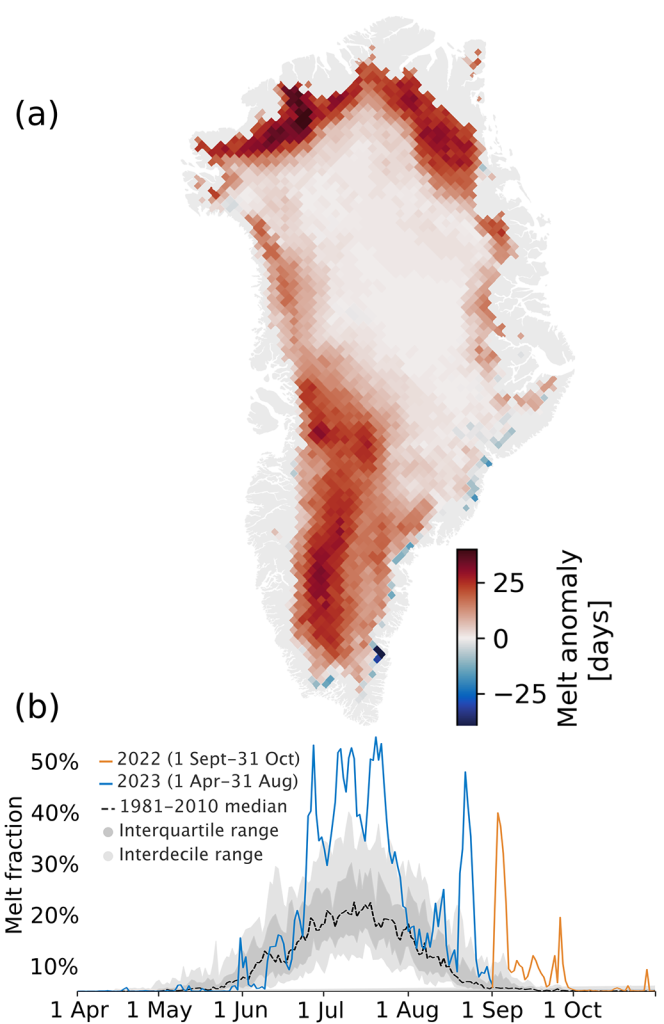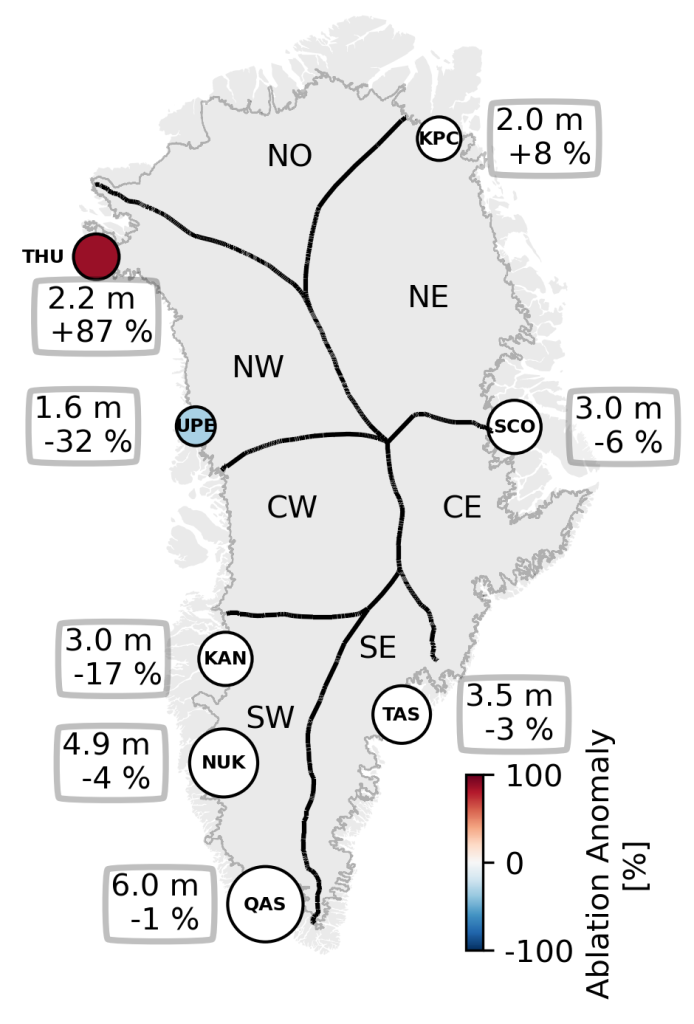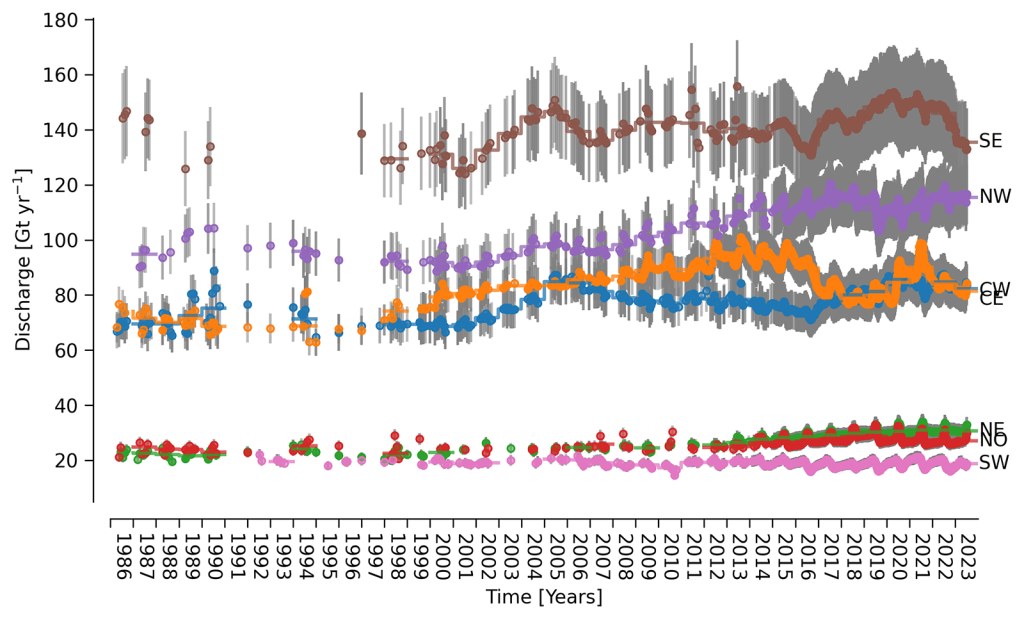K. Poinar1, K. D. Mankoff2,3, R. S. Fausto4, X. Fettweis5, B. D. Loomis6, A. Wehrlé7, C. D. Jensen8, M. Tedesco9, J. E. Box4, and T. L. Mote10
1University at Buffalo, Buffalo, NY, USA
2Goddard Institute of Space Studies, NASA, New York, NY, USA
3Autonomic Integra, New York, NY, USA
4Geological Survey of Denmark and Greenland, Copenhagen, Denmark
5SPHERES Research Unit, University of Liège, Liège, Belgium
6Goddard Space Flight Center, NASA, Greenbelt, MD, USA
7Department of Geography, University of Zurich, Zurich, Switzerland
8Danish Meteorological Institute, Copenhagen, Denmark
9Lamont-Doherty Earth Observatory, Columbia Climate School, Columbia University, Palisades, NY, USA
10Department of Geography, University of Georgia, Athens, GA, USA
Headlines
- Winter snow accumulation was above average this year, but the Greenland Ice Sheet still lost 156 ± 22 Gt of mass from 1 September 2022 to 31 August 2023 because discharge and melting exceeded accumulation.
- Summer high-pressure systems brought warm temperatures, widespread melting, and exceptional rainfall volumes.
- On 26 June 2023, Summit Station reached a temperature of 0.4°C and experienced melt for only the fifth time in its 34-year observational history.
Introduction
The Greenland Ice Sheet (GrIS) is the second-largest contributor of sea-level rise (SLR), after thermal expansion (Zemp et al. 2019). Ice mass loss from the GrIS affects environments and societies worldwide through coastal erosion, saltwater intrusion, habitat loss, increased flooding, and, in some locations, permanent inundation. In every year since 1998, the GrIS has lost mass overall. In the one-year period from 1 September 2022 to 31 August 2023, the GRACE-FO (Gravity Recovery and Climate Experiment Follow-on) satellite mission measured a total GrIS mass balance of -156 ± 22 Gt (mean ± 1 st. dev.), the equivalent of ~0.4 mm SLR (Fig. 1). This loss was 60 Gt (28%) less than the 2002-23 GrIS yearly average of -216 ± 8 Gt measured by GRACE/GRACE-FO.

Surface mass balance
Ice sheets gain mass from net snow accumulation and lose mass through meltwater runoff and solid ice discharge. The sum of accumulation and runoff is termed surface mass balance (SMB) and is primarily responsive to air temperature, snow cover, albedo, and bare-ice area. We summarize in-situ and satellite observations that influenced SMB over the 2023 mass balance year, 1 September 2022 through 31 August 2023, and report them relative to the 1991-2020 climatology unless otherwise stated.
We report monthly mean air temperatures measured at up to 32 weather stations in Greenland (see Methods and data). During autumn (SON 2022), temperatures were predominantly higher than average. At Summit Station, the autumn average was a record high of -23.2°C, a +7.4°C anomaly. Record-high temperatures were observed at seven stations along the west coast and Summit Station in September, and at three stations in southeast Greenland in November. Winter 2022/23 (DJF) and spring 2023 (MAM) had less remarkable temperature patterns. Most stations recorded temperatures close to or slightly below average during winter, and close to or slightly above average during spring. At Summit Station, the air temperature was slightly below average in winter (-0.9°C anomaly) and average in spring. There was generally above-average snow accumulation, but this was regionally variable. Accumulation near the coasts in southern and northeastern Greenland was slightly below average.
Cooler-than-average conditions characterized the beginning of the melt season at most weather stations. In the last week of June, however, a high-pressure system associated with the negative phase of the North Atlantic Oscillation arrived abruptly and persisted for four weeks. Its warm air incited multiple melt events across the ice sheet: the mean July temperature reached a record high of -7.3°C, which was a +4.4°C anomaly and was almost 2°C warmer than the previous record from 2012.
The total number of melt days across the GrIS (Fig. 2a) was above average virtually everywhere, and especially in northwest, northeast, and South Greenland, which experienced >20 more melt days than average. The cumulative melt-day area (Fig. 2b) was the second largest on record, at ~70% of the value from the 2012 record melt year and 5.7 times greater than the 1981-2010 average.


The generally mild winter conditions paired with the late-summer warmth yielded low melt-season (JJA) albedo, or broad-spectrum brightness (Fig. 3a), and high bare-ice area, especially in the lower accumulation zone and across southern and northeastern Greenland. The 2023 spatially averaged albedo ranked fifth lowest over the 2000-23 period covered by MODIS (Fig. 3b). The seasonal evolution of the albedo and bare-ice area proceeded similarly to the surface temperatures and melt. The ice sheet emerged from winter conditions later than average; early June showed the lowest bare-ice area measured in the 7-year Sentinel-3 observational record (Fig. 3c). For illustration, the bare-ice area measured on 15 June 2023 was only one tenth of that observed on 15 June 2019, a high-melt year. With the onset of high air pressures at the end of June, the bare-ice area increased rapidly, peaked on 23 July, and decreased through 8 August, when a large-areal melt event occurred (see Notable melt episodes). This pushed the bare-ice area to its seasonal maximum on 26 August. The summer albedo anomaly (Fig. 3a) was low (dark) across North and South Greenland, reaching -0.14 on the Qassimiut lobe. Across much of western Greenland, the albedo was higher (brighter) than normal at low elevations and lower (darker) than normal at higher elevations, over snow. This pattern coincided with a negative (cool) anomaly in summer 2-meter air temperature at low elevations and a positive (warm) anomaly at higher elevations.


Overall, the 2023 melt season ablation (ice melt) measured across eight Programme for Monitoring of the Greenland Ice Sheet (PROMICE) weather transects on the ice sheet (Fig. 4) was within 20% of the average at most stations. Exceptions occurred in the northwestern sector, where 2.2 meters of net ablation (87% more than average) was measured at Thule, and at Upernavik, where 1.6 meters (32% less than average) was measured. These full-summer values point to the combined effects of the cooler June and warmer July and August yielding overall near-average ablation at coastal locations.


Rainfall over the GrIS during the 2023 mass balance year was exceptional, more than 4 standard deviations above the mean. This was largely due to very high rainfall volumes in September 2022 and above-average rainfall in summer (JJA) 2023. As an example, the PROMICE weather station NUK_U, at 1100 m a.s.l., recorded 44 summer days with rainfall, totaling 140 mm.
In summary, ice discharge (see below) and basal mass balance for the 2023 hydrologic year from 1 September 2022 through 31 August 2023 were -504 ± 47 Gt and -27 ± 6 Gt, respectively (Mankoff et al. 2021). The total mass balance measured by GRACE/GRACE-FO was -156 ± 22 Gt, which yields a SMB of 375 ± 52 Gt. This derived SMB is slightly above regional climate model estimates of 240-395 Gt for the 2023 hydrologic year and is above the SMB climatology of 325 ± 29 Gt (mean ± 1 st. dev.) derived from daily regional climate model output summed annually and averaged over 1991-2020 (Fettweis et al. 2020; Mankoff et al. 2021).
Solid ice discharge
Discharge of solid ice decreases the overall mass balance of the ice sheet. This discharge occurs from the hundreds of marine-terminating glaciers that ring the GrIS and drain ice into the ocean. These glaciers are grouped by sector (see Fig. 4), each with several dozen glaciers, for regional pattern identification. In the 2023 calendar year, the glaciers in southeast (SE) Greenland discharged ice at the highest rate (145 ± 15 Gt/yr), although this has been slowing since the 2020 peak of 155 ± 17 Gt/yr (Fig. 5). The slowing trend since 2020 is fairly consistent across the SE region. Though this may seem to conflict with the above-average sea surface temperatures in the region (see essay Sea Surface Temperature), it is subsurface water temperatures that primarily affect glacier discharge (e.g., Wood et al. 2018).


The SE discharge decrease was partially offset by increases in the northwest (NW), Central East (CE), and northeast (NE). Across the entire GrIS, glaciers discharged ice at 489 ± 47 Gt/yr in 2023, which is within measurement uncertainties of the recent average of 497 ± 47 Gt/yr since 2013, but is likely below the 2020 peak of 513 ± 48 Gt/yr. The 2023 discharge rate falls below, but is within measurement uncertainties of, the recent trend of increasing discharge at +2.4 Gt/yr per year (1991-2020).
Notable melt episodes
The 2023 mass balance year began with a high-pressure system over southern Greenland. On 3 September 2022, SSMIS satellite sensors (see Methods and data) observed melt conditions on 36% of the ice-sheet surface (592,000 km2), an unprecedented extent for September. A second late-season melt event occurred later in the month when warm air associated with the aftermath of Hurricane Fiona reached Greenland: on 26 September 2022, the melt area peaked at 15% of the ice-sheet surface (245,000 km2). Both melt episodes coincided with significant rainfall events.
Another notable melt event occurred during an extended period of high pressure in August 2023. The high-pressure dome pulled southerly winds up the west coast to the northern ice divide, from where the air flowed back south and descended along the ice-sheet surface to the east coast. The compression induced by the descent caused warm, dry conditions along the north and east coasts; PROMICE stations there recorded temperatures as high as 16°C above the seasonal average.
Record melt rates and high temperatures across the upper elevations
In a single week in July, ablation lowered the ice-sheet surface at South Dome (elevation 2893 m a.s.l.) by 40 cm, a record pace of melt at that inland location. Summit Station (3216 m a.s.l.) reached a temperature of 0.4°C on 26 June; this was only the fifth time in the 34-year observational record that the air temperature at Summit has surpassed 0°C. (The fourth time occurred on 3 September 2022, described above.) On 22 August 2023, during the high-pressure period described above, the temperature at Summit Station reached -0.6°C.
Methods and data
The GRACE (Gravity Recovery and Climate Experiment, 2002-17) and GRACE-FO (Follow On, 2018-present) satellite missions detect gravity anomalies to measure changes in total ice mass (technical notes: podaac-tools.jpl.nasa.gov/drive/files/allData). The GRACE/GRACE-FO source data include ice-sheet-peripheral glaciers and ice masses that are not part of the GrIS. We scale these numbers by 0.84 to approximate changes only on the GrIS (Colgan et al. 2015).
Weather data are directly obtained from 20 Danish Meteorological Institute (DMI) land-based weather stations with records starting from 1784 (Nuuk), 11 stations owned by Mittarfeqarfiit A/S, which operates airports and helipads, and data from Summit Station. NOAA GEOSummit has supplied data from Summit since 2019; we extend this to 1991 using the DMI station at Summit. Eight automatic weather station transects from the Programme for Monitoring of the Greenland Ice Sheet (PROMICE) at the Geological Survey of Greenland and Denmark (GEUS) provide temperatures and surface ablation measurements, following van As et al. (2016).
Surface melt duration and extent are derived from daily Special Sensor Microwave Imager/Sounder (SSMIS) 37 GHz, horizontally polarized passive microwave radiometer satellite data (Mote 2007).
Albedo monitoring since 2000 is from NASA MODIS satellite data (Box et al. 2017). The bare ice area is monitored using the Sentinel-3 SICE product (Kokhanovsky et al. 2020; Wehrlé et al. 2021).
PROMICE combines ice thickness estimates with ice velocity measurements based on Sentinel-1 satellite data to create a Greenland-wide, time-evolving solid-ice discharge product integrated over Greenland (Mankoff et al. 2020).
Acknowledgments
K. Mankoff was supported by the NASA Modeling Analysis and Prediction program. M. Tedesco was supported by National Science Foundation OPP 1713072, OPP 2136938, and PLR-1603331, National Aeronautics and Space Administration (NASA) 80NSSC20K1254, and Heising-Simons Foundation 2019-1160. T. Mote was supported by National Science Foundation #1900324. Data from the Programme for Monitoring of the Greenland Ice Sheet (PROMICE) were provided by the Geological Survey of Denmark and Greenland (GEUS) at www.promice.dk. Sentinel-3 SICE data processing via PolarView.org was enabled by the European Space Agency (ESA) Network of Resources Initiative. Summit Station is owned and operated by the National Science Foundation Office of Polar Programs with permission from the Government of Greenland.
References
Box, J. E., D. van As, and K. Steffen, 2017: Greenland, Canadian and Icelandic land-ice albedo grids (2000-2016). GEUS Bull., 38, 53-56, https://doi.org/10.34194/geusb.v38.4414.
Colgan, W., and Coauthors, 2015: Hybrid glacier Inventory, Gravimetry and Altimetry (HIGA) mass balance product for Greenland and the Canadian Arctic. Remote Sens. Environ., 168, 24-39, https://doi.org/10.1016/j.rse.2015.06.016.
Fettweis, X., and Coauthors, 2020: GrSMBMIP: intercomparison of the modelled 1980-2012 surface mass balance over the Greenland Ice Sheet. Cryosphere, 14, 3935-3958, https://doi.org/10.5194/tc-14-3935-2020.
Kokhanovsky, A., J. E. Box, B. Vandecrux, K. D. Mankoff, M. Lamare, A. Smirnov, and M. Kern, 2020: The determination of snow albedo from satellite measurements using fast atmospheric correction technique. Remote Sens., 12, 234, https://doi.org/10.3390/rs12020234.
Mankoff, K. D., A. Solgaard, W. Colgan, A. P. Ahlstrøm, S. A. Khan, and R. S. Fausto, 2020: Greenland ice sheet solid ice discharge from 1986 through March 2020. Earth Syst. Sci. Data, 12, 1367-1383, https://doi.org/10.5194/essd-12-1367-2020.
Mankoff, K. D., and Coauthors, 2021: Greenland ice sheet mass balance from 1840 through next week. Earth Syst. Sci. Data, 13, 5001-5025, https://doi.org/10.5194/essd-13-5001-2021.
Mote, T. L., 2007: Greenland surface melt trends 1973-2007: Evidence of a large increase in 2007. Geophys. Res. Lett., 34, L22507, https://doi.org/10.1029/2007GL031976.
Tapley, B. D., and Coauthors, 2019: Contributions of GRACE to understanding climate change. Nat. Climate Change, 9, 358-369, https://doi.org/10.1038/s41558-019-0456-2.
van As, D., R. S. Fausto, J. Cappelen, R. S. van de Wal, R. J. Braithwaite, H. Machguth, and PROMICE project team, 2016: Placing Greenland ice sheet ablation measurements in a multi-decadal context. GEUS Bull., 35, 71-74, https://doi.org/10.34194/geusb.v35.4942.
Wehrlé, A., J. E. Box, M. Niwano, A. M. Anesio, and R. S. Fausto, 2021: Greenland bare-ice albedo from PROMICE automatic weather station measurements and Sentinel-3 satellite observations. GEUS Bull., 47, 5284, https://doi.org/10.34194/geusb.v47.5284.
Wood, M., E. Rignot, I. Fenty, D. Menemenlis, R. Millan, M. Morlighem, J. Mouginot, and H. Seroussi, 2018: Ocean-induced melt triggers glacier retreat in Northwest Greenland. Geophys. Res. Lett., 45, 16, 8334-8342, https://doi.org/10.1029/2018GL078024.
Zemp, M., and Coauthors, 2019: Global glacier mass changes and their contributions to sea-level rise from 1961 to 2016. Nature, 568, 382-386, https://doi.org/10.1038/s41586-019-1071-0.
November 21, 2023
